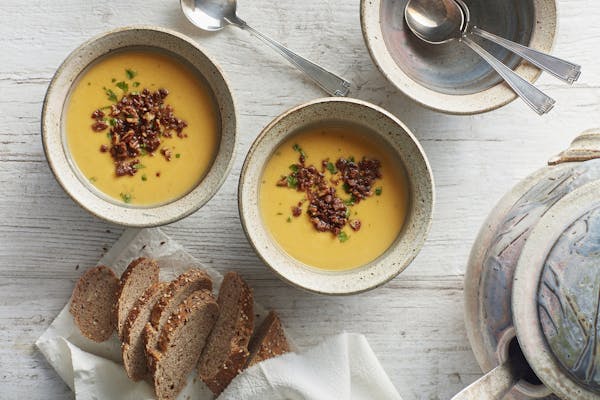After weeks of excess, you may be ready to settle into a new eating pattern for a new year, one that's a little lighter and whole lot easier. Nothing fits that description better than soup.
It's tailor-made for winter meals, comfort in a bowl, love on a spoon, satisfaction simmering on the stove. All that, and it comes together so easily. Whether you make it all from scratch, starting from the stock, or you purchase stock and a few other ingredients for a quick and easy meal, soup never fails.
In a perfect world, everyone would make stock from scratch. Homemade stock can turn a simple soup, stew or sauce into something special. It has a deep, rich flavor and, in the case of beef or chicken stock, plenty of gelatin, which adds critical body to sauces and soups. The good news is that stock is much easier to make than you might think, especially when you use either a slow cooker or pressure cooker.
Of course, a stock pot is the tried and true piece of equipment for this task, and it works just as well today as it did a hundred years ago, but there are some advantages to upgrading to a more modern method. In the case of the slow cooker, you can put all your ingredients in, turn it on and let it simmer away all day (or overnight) without needing any attention. A stock that's cooked for eight hours is going to have pulled all the flavor possible from the ingredients, resulting in deep flavor.
Another method — a pressure cooker (or the more recent Instant Pot-style cooker) creates steam in a sealed chamber, which drives the boiling point temperature higher than you would get on the stove. The result for both is that the method extracts more flavor from the meat and vegetables and breaks down any connective tissues more effectively. It also does this in a fraction of the time it would take using more traditional methods.
There are endless options when it comes to the type of stocks you can make. Beef, chicken, pork, lamb, fish and vegetable are all common varieties. In my kitchen, I most often make chicken stock, which I find to be the most versatile.
Then I generally roast chicken and vegetables before cooking them in water. Roasted chicken stock has an even deeper flavor and color than unroasted stock, which means it can often be used in place of beef stock, if that's not available. The difference between the two is like that between a poached chicken breast and a roasted chicken breast. Poached can be lovely, but it's much more subtle than the robust flavor of roasted chicken.
One "secret" ingredient I use is a touch of soy sauce. It gives an added umami flavor which brings an extra dimension to the stock with almost no effort.
If time is short and you need to purchase stock, I stick to the low-sodium varieties, which give you more control when it comes to seasoning your soup.
The basics of making soup
If you can turn on the stove and throw a few ingredients into a pot, you can make soup. It's that easy. Of course, to make that soup good, there are a few other elements to keep in mind.
First, you'll want to think about what kind of soup you want. Are you looking for a brothy soup? A chunky soup? Or a soup that's silky smooth from being puréed?
If you'd like your soup to have hearty, deep, bold flavors, you'll want to start off by browning your meat or vegetables well over high heat, as I do with the following recipes for Slow Cooker Beef and Vegetable Soup. Or roast the vegetables, which will also intensify their flavor, as in the Roasted Butternut Ginger Soup.
For a more subtle flavor, you'll want to sauté the vegetables over a lower heat. You're not trying to brown them, but bringing out their natural sweetness. In Tuscan Chicken and White Bean Soup, we want the flavor of the herbs and beans to stand out, so we don't brown the chicken thighs at all. They simply simmer gently until they are cooked through, before we shred them into bite-sized pieces.
As is true in the stock, I often find myself adding a dash of soy sauce or even fish sauce to a soup to deepen its flavor. Parmesan cheese will also give it an extra boost of umami, which is why I never throw away the rind on a chunk of Parmigiano-Reggiano cheese. You can add the rind, in one piece, to almost any soup.
Sometimes a soup should be light and brothy, but when you're looking for a thicker texture, many cooks choose to create a roux by adding flour, and perhaps added fat, to the sautéed vegetables at the beginning of the cooking process. While that technique works to create a thicker broth, it can dilute the flavor of the soup.
For that reason, whenever possible, I like to remove some of the soup and purée it. Then I add it back to the pot, where it gives the soup body and creaminess, without detracting from its flavor or adding extra fat. This technique works well with bean or vegetable soups.
And don't forget the last step: Adding a little acid at the end of the cooking process to boost the flavor of all the other ingredients. This allows you to eliminate or cut back added salt.
Meredith Deeds in a Minneapolis writer. Follow her on Instagram: @meredithdeeds.






